It seems we can’t find what you’re looking for. Perhaps searching can help.


Tag: ecommerce




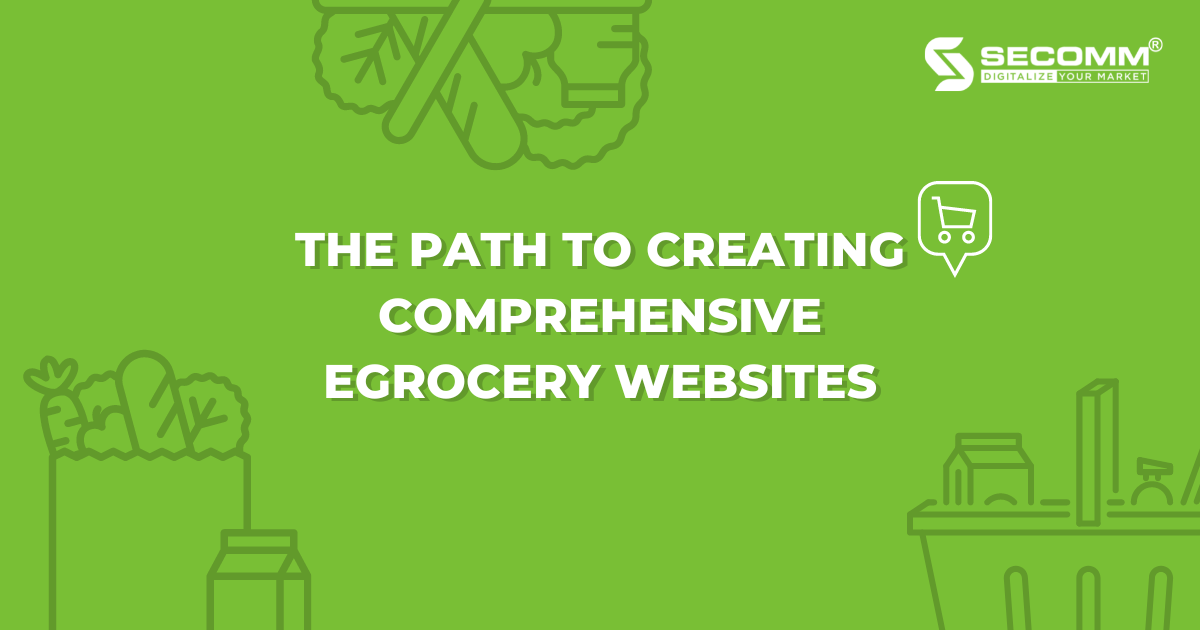
THE PATH TO CREATING COMPREHENSIVE EGROCERY WEBSITES
According to Statista, the size of the Vietnamese ecommerce market in 2021 was $13 billion and is expected to reach $39 billion in 2025, ranking second in Southeast Asia behind only Indonesia. The spectacular breakthrough of the grocery eCommerce industry has coincided with the explosion of the eCommerce market. As a result, online grocery shopping has become a part of 53 percent of consumers’ habits.
Grocery companies should create their eCommerce website as soon as possible to jump into the bigger game and develop online grocery business activities to capitalize on the enormous potential of the eGrocery market and gradually transition to digital transformation.
SECOMM has outlined the journey to create a comprehensive eGrocery website for the Vietnamese market with over 7 years of experience in eCommerce.
The initial stage: Basic eGrocery website development
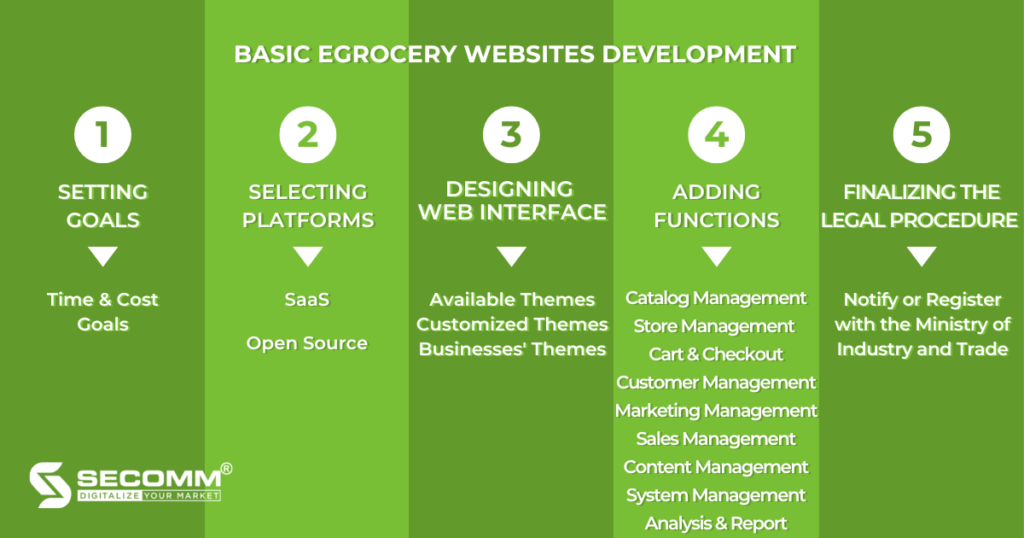
Setting goals for the development of the eGrocery website
The first step for grocery businesses is to set goals and prioritize those goals to plan the result of an appropriate eCommerce website for each stage.
Businesses can consider long-term goals such as brand positioning, exploitation of potential customers, and product online business capability.
Short-term goal activities such as revenue growth, customer monitoring and analysis, campaign effectiveness evaluation, and so on should prioritize by businesses.
Furthermore, the user experience factor, which includes services such as payment, logistics, online customer care, and so on, is critical to increasing interaction, support, customer consultation, and problem resolution as quickly as possible.
In terms of duration, businesses can choose to deploy quickly to penetrate the eGrocery market or gradually adapt to the market at this stage. When deploying a grocery ecommerce website, the budget will be determined by each business’s strategy and financial potential.
Selecting a basic eGrocery website development platform
Two popular platforms assist businesses in developing eCommerce websites: SaaS (Software as a service) and Open Source. Here are some of the best Saas eCommerce platforms: Haravan, Shopify, and BigCommerce.
- Pros: Rapidity, reasonable price, no IT experience requirement
- Cons: Operating costs rise over time as a result of annual/monthly service license payments, platform developer reliance due to lack of ownership of source code and data, and limited functions such as the ability to integrate and expand the website system.
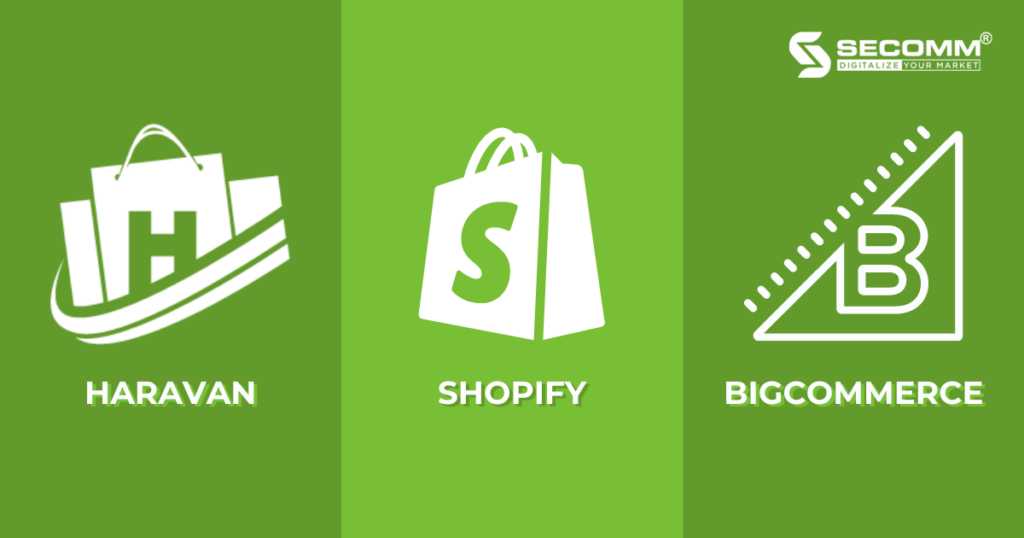
Open Source eCommerce Platforms widely used in the Vietnamese market include WooCommerce, OpenCart, and Magento.
- Pros: The user owns the source code and data, has more interfaces and functions, and has better integration and extensibility than SaaS platforms.
- Cons: It takes more time and cost to develop the website initially than SaaS platforms. Also, it requires an experienced IT team to handle its system.
Due to the significant differences between SaaS Platforms and Open Source Platforms, stage businesses prefer to use SaaS Platforms in the initial stages of basic eGrocery
Designing the interface of the eGrocery website
Businesses have to meet the following criteria when designing the website interface: UI/UX standardization, displaying the brand’s and the eGrocery industry’s characteristics, and product presentation synchronization to provide the best experience to customers.
There are three approaches to designing the interface: using available themes, customizing themes, or creating their own. Businesses frequently use the available themes in this stage to save the most money. Still, some companies with financial potential will choose the other two options for better branding.
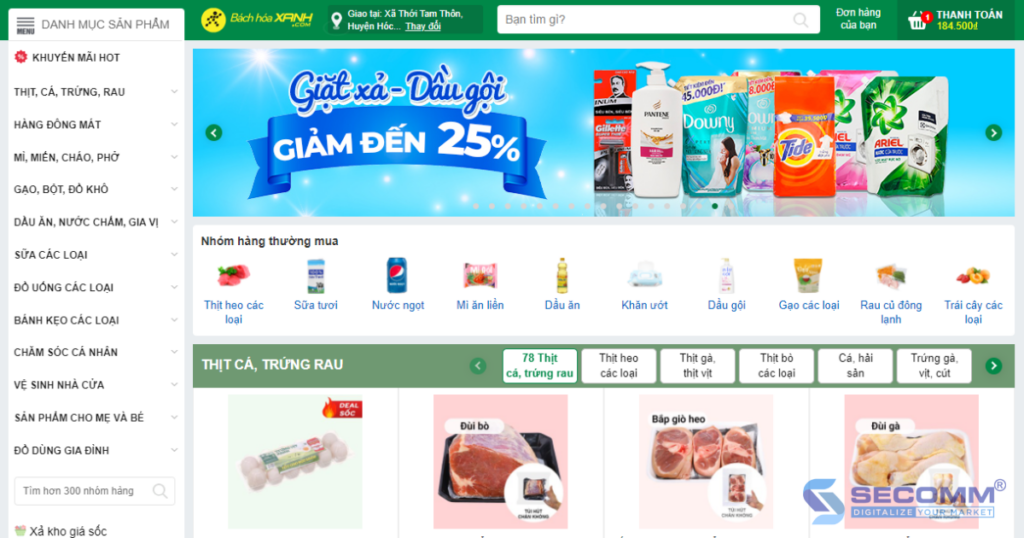
Adding functions to the eGrocery website
When operating a grocery eCommerce system, businesses can prioritize the development of basic functions to meet the essential needs during this time.
Some basic functions required in eGrocery websites, such as:
- Catalog Management: Manage all data, processes, categories, attributes, prices, inventory quantities, and images/videos to operate and optimize the efficiency of the online grocery store.
- Store Management: Manage product inventory and each branch’s business activities and personnel.
- Cart and Checkout: Manage the shopping cart and customers’ information when they check out.
- Customer Management: Manage customer information to increase marketing efficiency, purchase experience, and customer satisfaction.
- Marketing Management: Optimize SEO and implement marketing strategies with tools to increase business sales.
- Sales Management: Create and manage sales, order, payment, and shipping processes.
- Content Management: Create and optimize all content elements for CMS pages, image storage, customize themes, and design websites.
- System Management: Delegate administrators to review the best methods for website security and maintenance
- Analysis and Report: Help track and measure eCommerce system performance and develop future strategies.
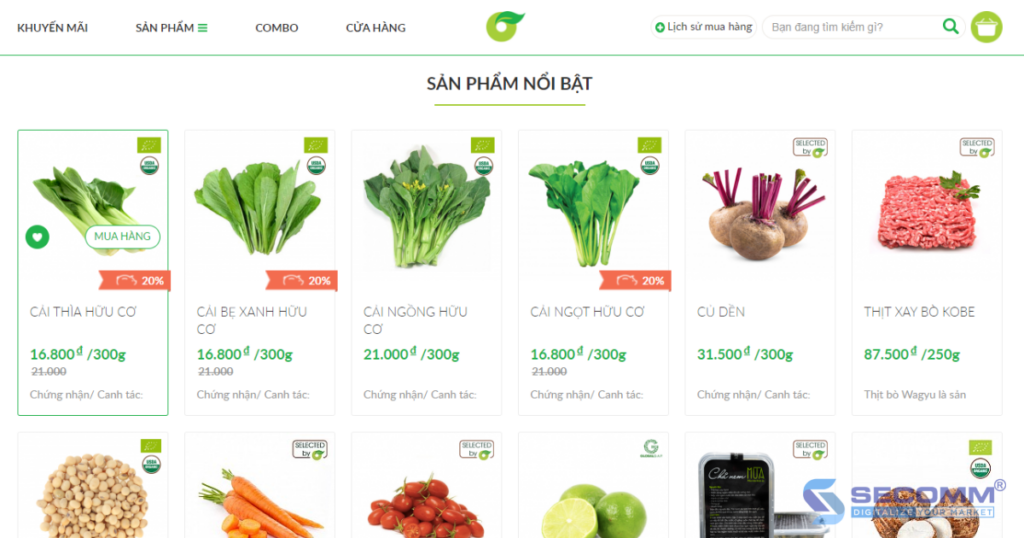
Finalizing the legal procedures
According to Decree 52/2013/ND-CP of the Government, every individual or organization that owns a sales eCommerce website must notify or register with the Ministry of Industry and Trade on the eCommerce Operation Management Portal.
Websites that exceed the time limit or fail to register/notify the competent management agency within the time frame specified will be administratively sanctioned by regulations.
The following stage: Advanced eGrocery website development
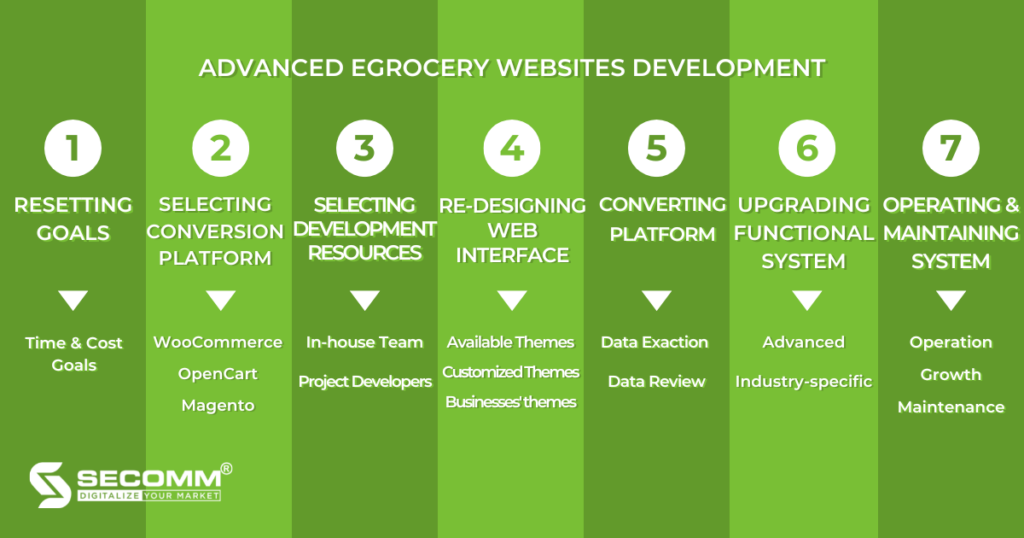
Re-targeting
As the company grows and the market changes, the goals must be adjusted accordingly. This is also the time for leaders to rethink the business strategy’s target and money to invest in the grocery eCommerce website system. During this time, businesses frequently focus on the short and long-term goals of expanding the online grocery store system.
Long-term business goals can include expanding market segments, developing loyalty programs, forming consumer online shopping habits, etc.
Short-term goals for businesses can include capturing more new potential customers, increasing revenue, and supporting Ecommerce Marketing strategy.
Selecting platforms for conversion
When SaaS platforms are no longer effective enough to help businesses expand their online grocery store website systems, they have to turn to Open Source platforms like Magento, WooCommerce, and OpenCart to build advanced eGrocery websites.
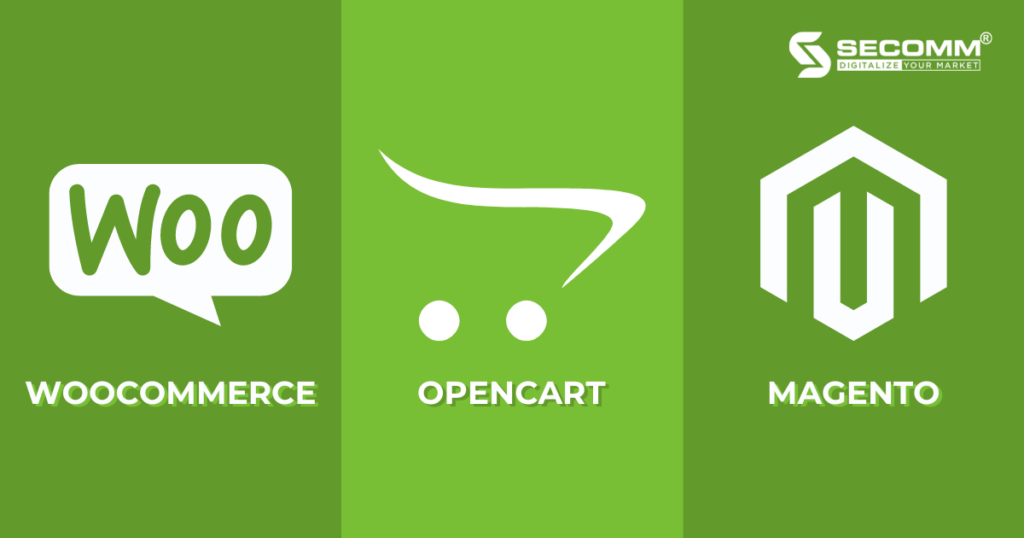
In this stage, platform selection criteria include:
- Professional website interface, UX / UI standardization, displaying the brand’s and the eGrocery industry’s characteristics.
- Comprehensive functional system from basic; advanced to industry-specific
- Flexible customization and extensibility, allowing businesses to integrate with a wide range of third-party utilities and support multiple websites, multi-language, and multi-currency.
- High security, assisting businesses in avoiding network attacks, and assisting with data backup when needed
Absolutely, businesses will face more challenges when switching platforms from SaaS to Open Source, such as changing costs, time to train personnel on open platforms, and data loss or errors during the conversion.
Selecting the development resources (In-house team or Project developer)
Businesses must choose the right resources to develop their website to build eCommerce website on an open source platform. Typically, companies can create an in-house team or find a project developer. Regardless of the resource, professional knowledge and practical experience about the chosen platform are required.
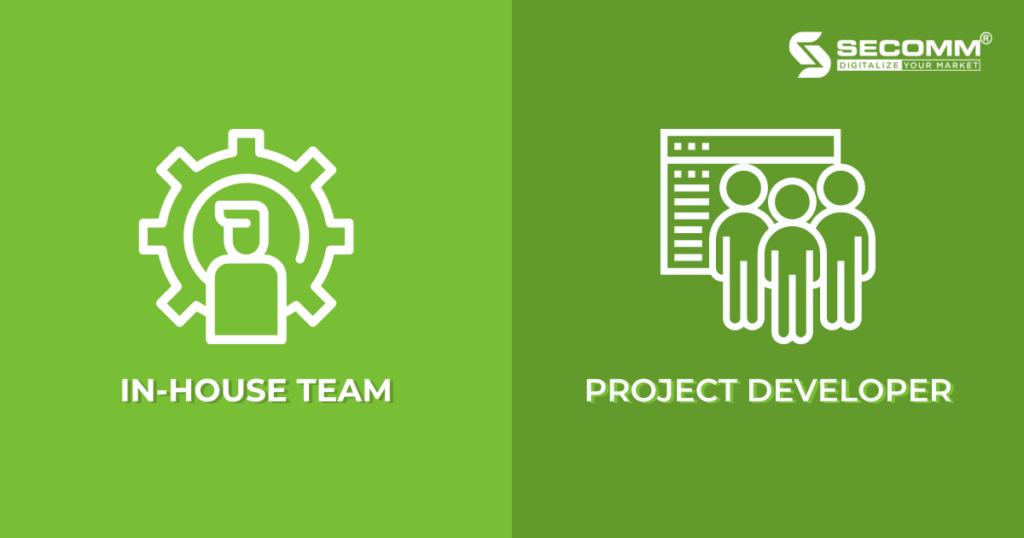
Businesses should recruit and train IT and eCommerce personnel with expertise and experience in the chosen platform. Building the right team will take a lot of time and money. Still, it will help businesses manage resources better and actively edit or develop the website system according to the requirements.
Businesses should look for project developers based on the following criteria to collaborate with them:
- Ecommerce experience (the number of years of experience, the quantity and the quality of projects they have done, and the complexity of projects).
- The professional team (solution consultants, IT personnel, customer service).
- Good process (analyzing, proposing solutions, developing, testing, and maintaining).
- Fast processing and support capabilities.
- Warranty and maintenance commitments.
This will help businesses learn expertise, gain experience, and develop a website in all aspects of the eGrocery industry. Still, companies and their partners must collaborate effectively to achieve a better result.
Re-designing the interface of the eGrocery website
Businesses can keep things the same while switching platforms. There is no need to change the current website interface. Many companies, however, will rebuild the website interface to match the new strategy and platform.
Similar to the previous stage, businesses have several options when designing the interface of a grocery eCommerce website: using available themes, customizing the themes, or creating their own. At this stage, however, businesses frequently choose to customize or design their own theme to reflect the characteristics of the eGrocery brand and industry.
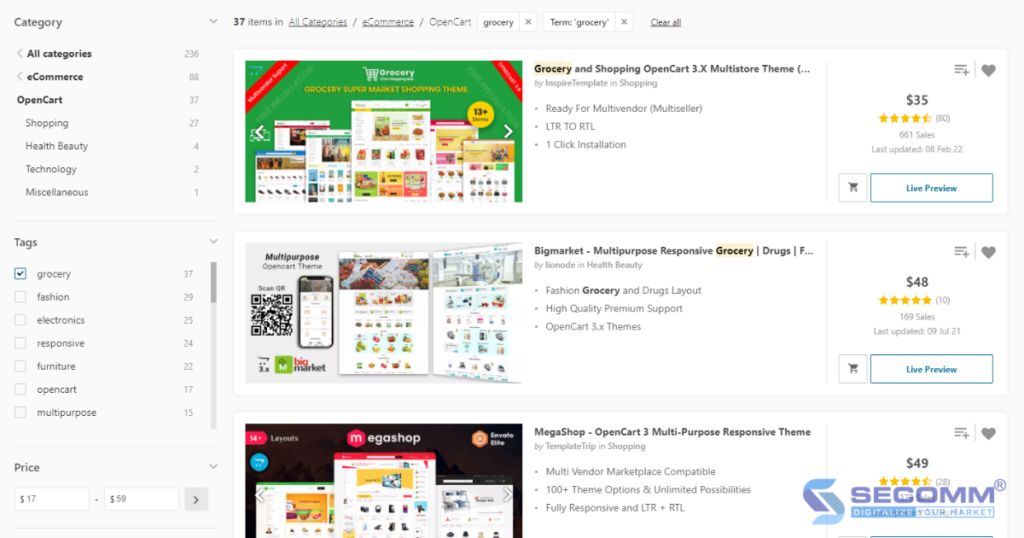
Converting platform
After selecting the appropriate conversion platform, the conversion should be carried out carefully to limit the risk of data loss or enterprise error. To avoid errors, the conversion is usually done as automatically as possible.
The platform conversion process includes steps to extract data from the old system and record it into the new system. After converting the platform, businesses need to double-check to ensure that the converted data is fully and correctly according to the plan.
Upgrading functional system
In addition to the basic functions, businesses should focus on developing a more complex system of functions, including advanced and industry-specific functions for the eGrocery industry.
Advanced functions include order tracking, abandoned cart, similar product recommendations, advanced product search, multilayer product catalog, and others that improve the consumer experience and speed up the shopping process.
Industry-specific functions aid in thoroughly resolving the challenges of implementing intensive departmental eCommerce, meeting the needs of customer segments and businesses such as fast delivery, delivery time selection, and so on.
Furthermore, businesses must constantly update and develop user-friendly functions to stay competitive in the market.
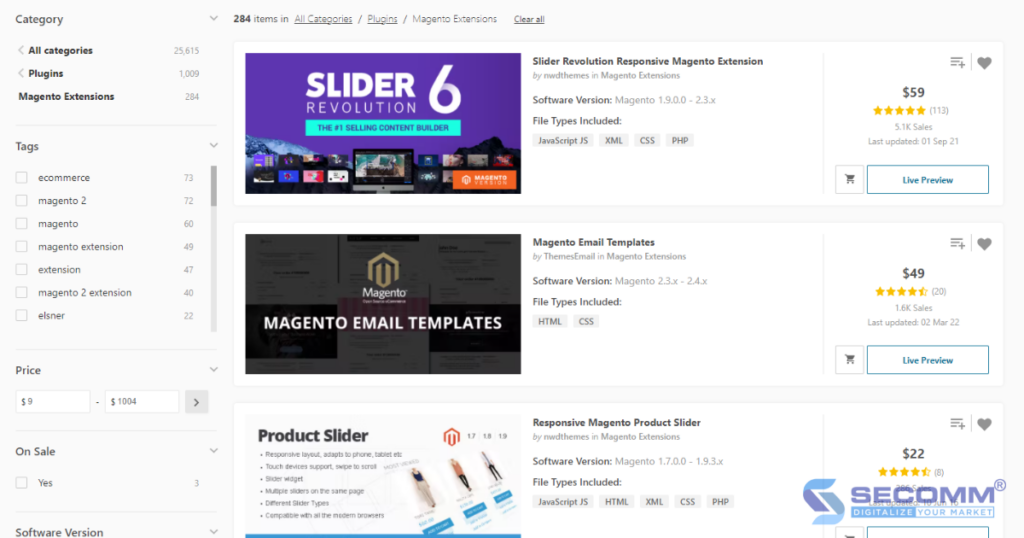
Operating and maintaining the eGrocery website system
When putting the grocery eCommerce website system through testing, businesses must review and test the entire website and functionality in a specific time frame to ensure order processing speed, website stability, and so on. In addition, businesses must immediately contact the in-house team or the developer if issues arise to adjust and improve the website before going live.
After the grocery eCommerce website system has stabilized, businesses should focus on Ecommerce Marketing strategies (SEO, SEM, Email Marketing, Content Marketing, Social Marketing, and so on) or implement Omni-channel to grow their online eGrocery business.
For long-term sales growth, businesses should maintain, update, and upgrade their website system regularly, quickly adapting to changes in the eCommerce market in general and the grocery market in particular.
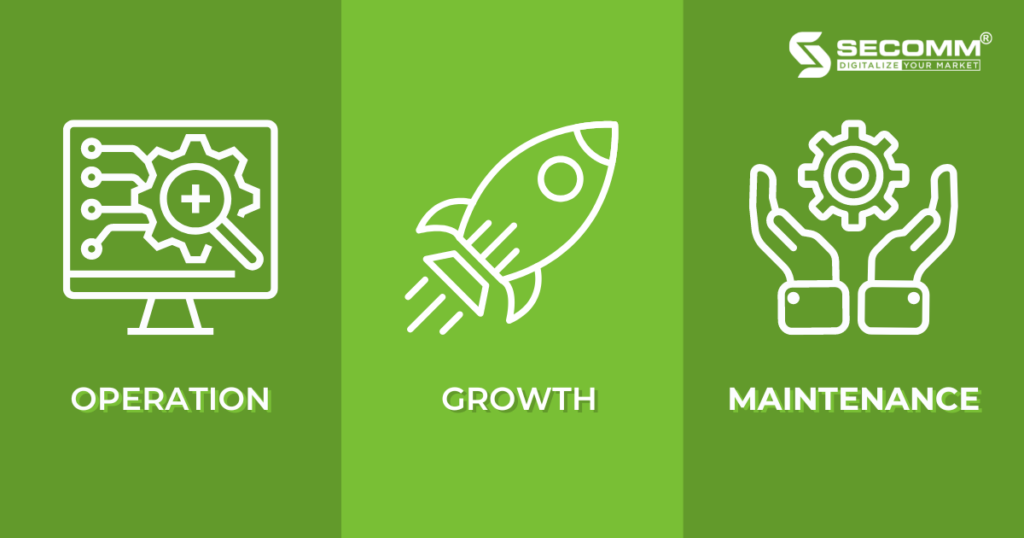
In general, developing comprehensive eGrocery websites for the Vietnamese market is complex. It requires businesses to invest significant time and money in researching the best eCommerce strategy for each stage of business development.
Our company – SECOMM, has been partnering with many big enterprises such as An Nam Group (Vietnam), Jasnor (Australia), and Changi Airport Group (Singapore). As a result, we are aware of the challenges and worries firms face while developing an eCommerce website system.
Get in touch with us now for FREE eCommerce consultancy and solutions in eGrocery businesses.
 2
2

 2,693
2,693

 1
1

 1
1
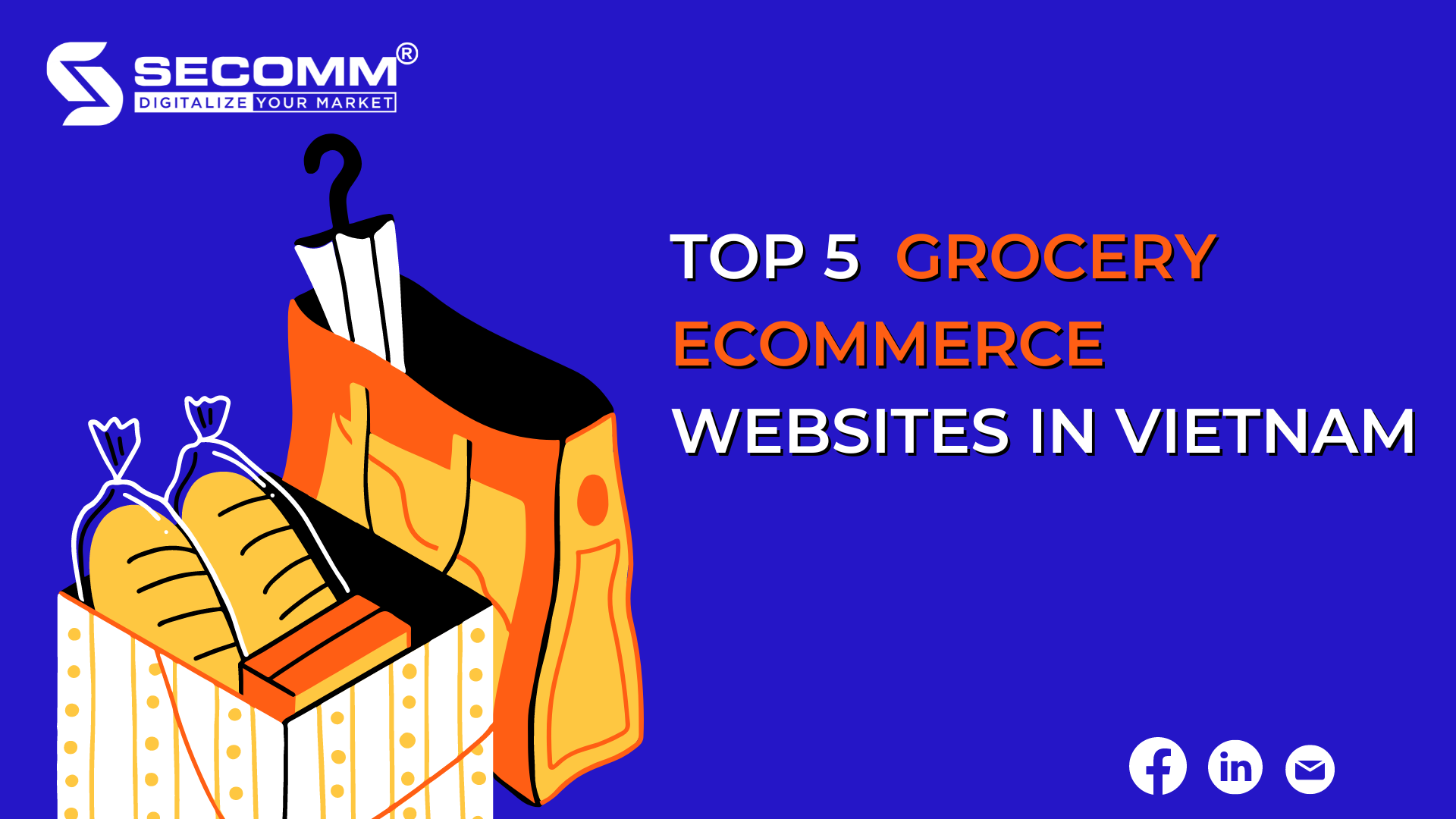
TOP 05 GROCERY ECOMMERCE WEBSITES IN VIETNAM
Grocery eCommerce is a trend in eCommerce that allows customers to buy goods online. This is regarded as the leading industry in the eCommerce market, particularly in Vietnam. According to an iPrice report, when people began staying at home to avoid the Covid-19 epidemic, traffic to websites specializing in the grocery business increased 45% faster than before. This trend remained stable after the social distancing was reduced, increasing by 10% at the end of the year. Online grocery is the only category that has seen consistent growth throughout the pandemic, with search demand continuing to rise.
There are some popular grocery eCommerce websites in Vietnam can be mentioned as:
Bach Hoa Xanh
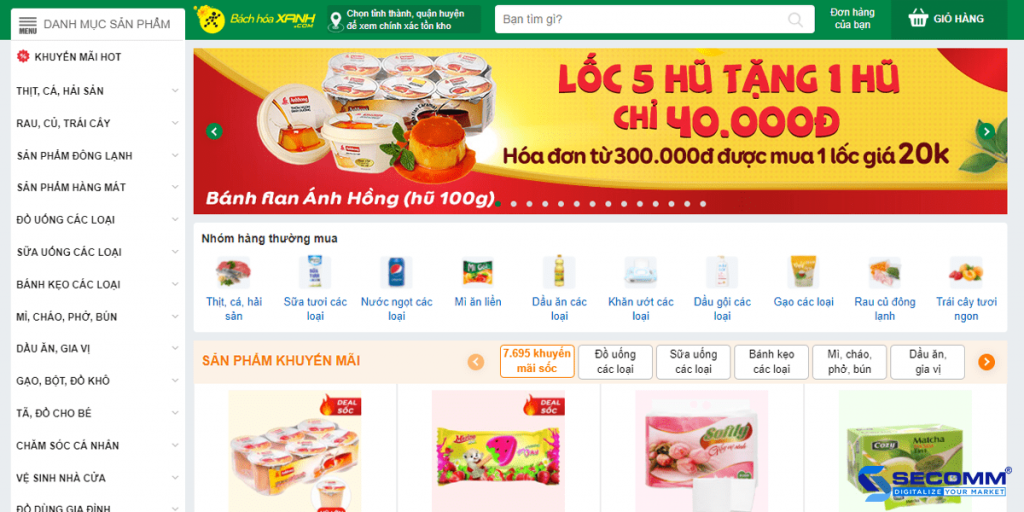
Bach Hoa Xanh is one of the most popular grocery store chain owned by Mobile World Joint Stock Company that specializes in selling fresh food and necessities. Bach Hoa Xanh currently operates nearly 2,000 stores in the South, East, and South Central provinces. This is the most visited website in the top five most visited websites in the Vietnam market, behind only the top four eCommerce platforms today, namely Shopee, Lazada, Tiki, and Sendo (According to iPrice).
– Website: https://www.bachhoaxanh.com/
– Traffic: 1.1M/month
WinMart

WinMart is a supermarket system and grocery store chain purchased by Masan Group from Vingroup. This brand was more commonly known as Vinmart at that time.
– Website: https://winmart.vn/
-Traffic: 209.5K/month
Organica
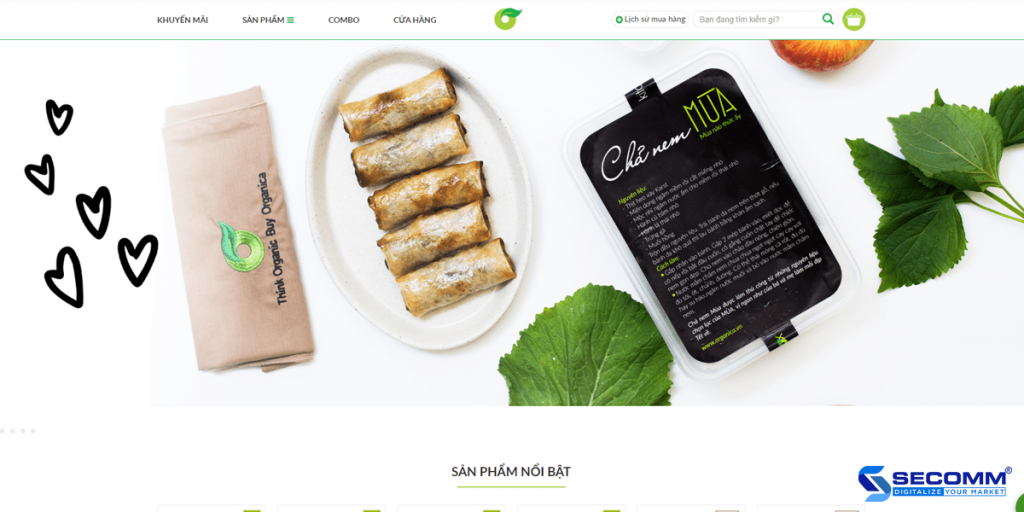
Organica is a natural and non-GMO certified organic food development and distribution system.
– Website: https://www.organica.vn/
– Traffic: 27.2K/month
Farmer’s Market

Farmer’s Market is a fresh food chain store brand managed by LARIA Trading Co., Ltd. To provide a seamless shopping experience O2O (online to offline), the company has built an omni-channel retail system serving over 4,000 customers daily.
– Website: https://farmersmarket.vn/
– Traffic: 17.5K/month
Annam Gourmet

Annam Gourmet arose from the two Annam Group founders’ deep love of European cuisine. Annam Gourmet chain stores have been successfully operating in the Vietnamese market for over 20 years, offering high-quality imported product lines such as high-end food, wine, beverages, and cosmetics.
– Website: https://shop.annam-gourmet.com/
-Traffic: 8.7K/month
Grocery eCommerce Solutions
With a 200% annual growth rate, the future potential of grocery eCommerce in the Vietnamese market is undeniable (according to Statista). There are numerous opportunities in the eGrocery industry. Recently, many challenges have arisen, necessitating careful consideration of tactics by business managers in order to take the most effective steps.
The eGrocery businesses have opportunities and challenges, requiring business managers to consider tactics to take the most effective steps. Finding a partner is tricky and building an in-house team is tough. Businesses must incur significant opportunity costs and time to reach the goal.
Our company – SECOMM has been partnering with many big enterprises such as An Nam Group (Vietnam), Jasnor (Australia), and Changi Airport Group (Singapore). We are aware of the challenges and worries faced by firms while developing an e-commerce website system.
Get in touch with us now for FREE eCommerce consultancy and solutions in eGrocery businesses.
 2
2

 4,650
4,650

 0
0

 1
1
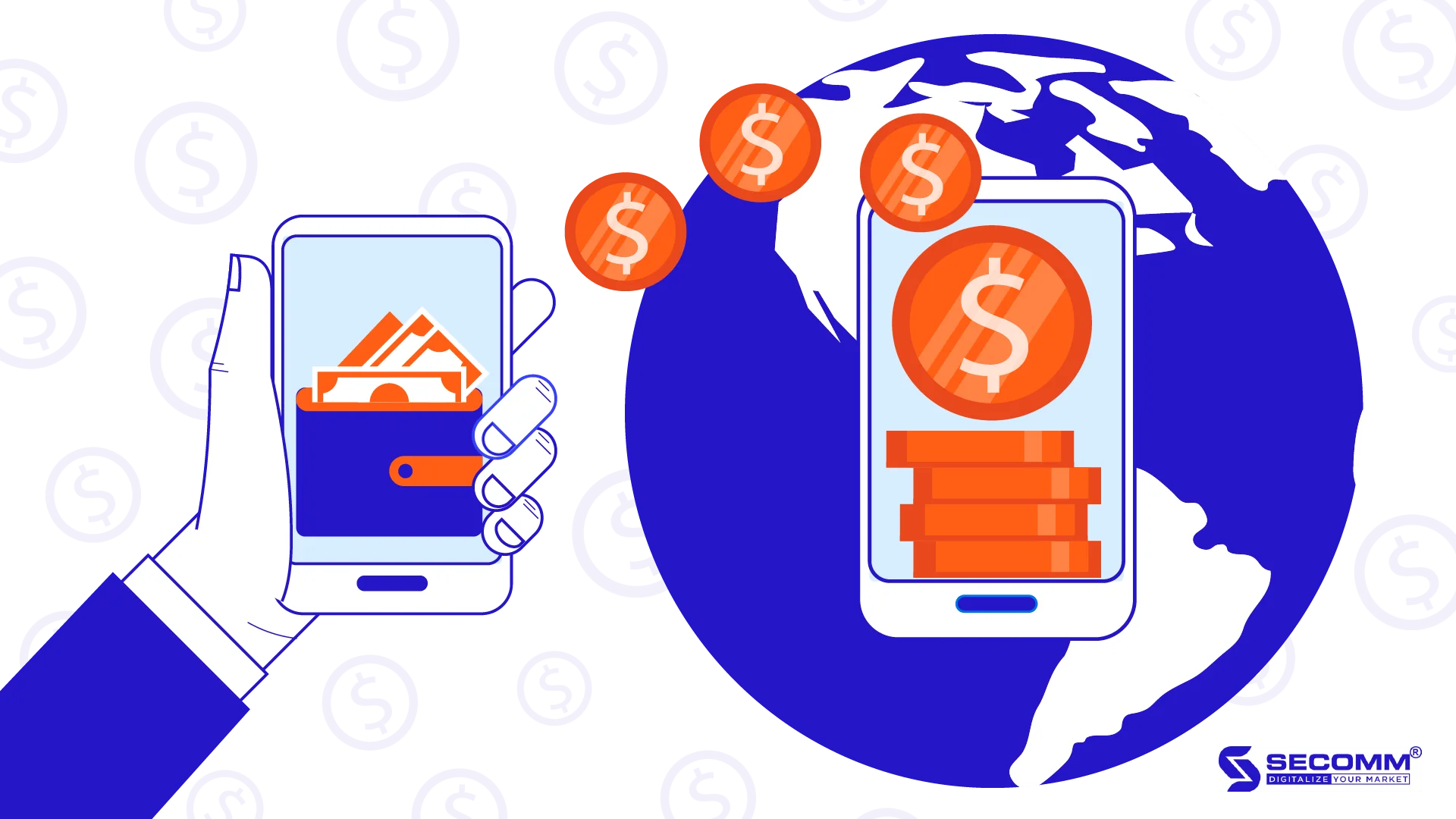
TOP 7 PAYMENT METHODS IN ECOMMERCE
Payment services play a crucial role in ecommerce. Diversifying payment methods can provide a more complete shopping experience for consumers, maximise revenue, and enhance the brand for businesses.
Here are some payment methods in ecommerce:
COD (Cash On Delivery): Pay upon receiving the goods
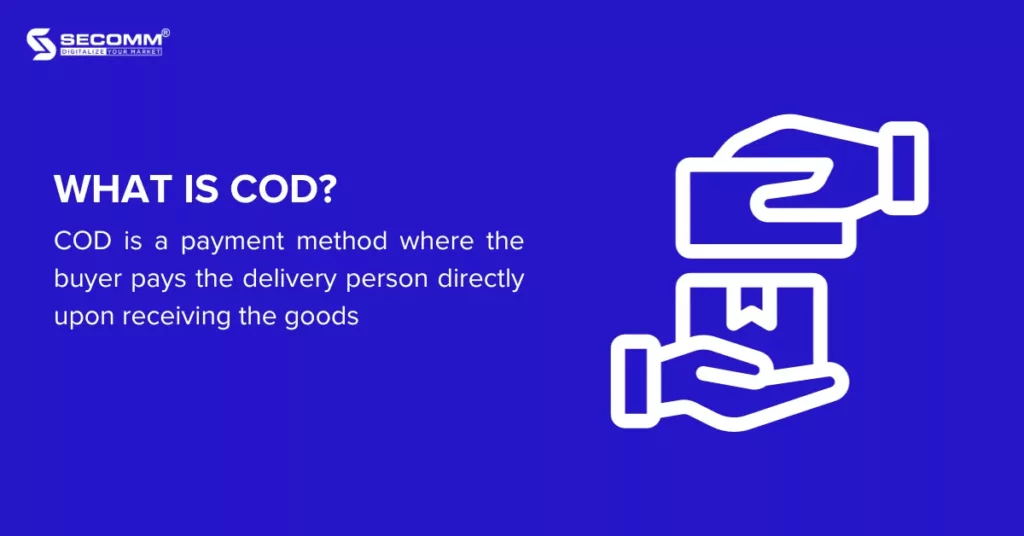
COD is a payment method where the buyer pays the delivery person directly upon receiving the goods. Buyers don’t have to pay in advance when placing an order, and if the products are not satisfactory, they have the right to refuse and return the items.
- Popularity: 78% (2020)
- Benefits:
- Sellers:
- Build trust with customers when shopping online.
- It boosts orders and increases revenue as buyers don’t have to pay upfront.
- Buyers:
- Allow payment after checking the products, helping customers avoid receiving unwanted items.
- Limit the risk of personal or card information theft on websites with weak security.
- Sellers:
Bank transfer
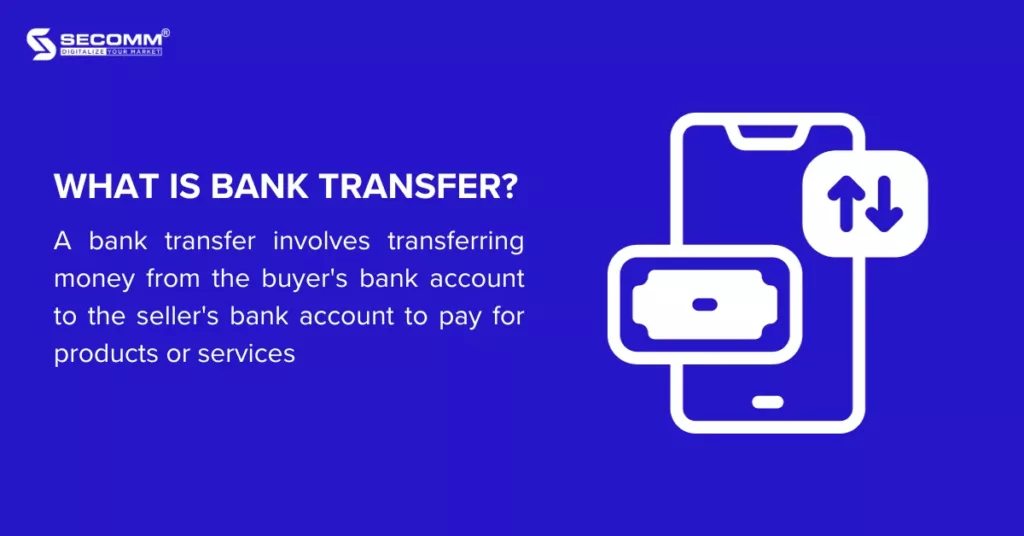
A bank transfer involves transferring money from the buyer’s bank account to the seller’s bank account to pay for products or services. Modern bank transfer methods, such as Internet Banking and Mobile Banking are replacing traditional ATM transfers.
- Popularity: 39% (2020)
- Benefits:
- Quick transactions through Internet Banking or Mobile Banking.
- It saves shopping time.
- Easy control of transaction information.
- Limits the risks associated with using cash, such as theft.
Online payment gateways
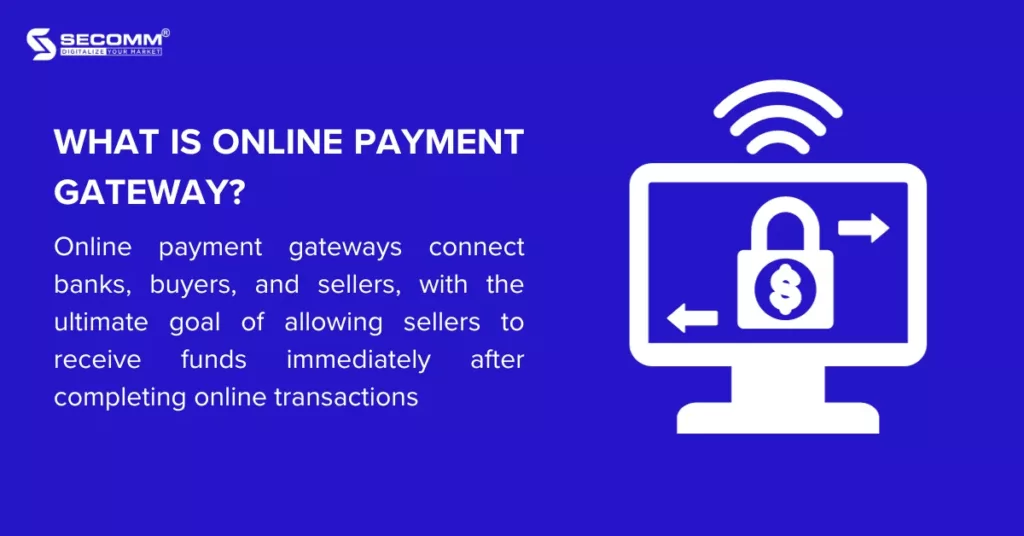
Online payment gateways connect banks, buyers, and sellers, with the ultimate goal of allowing sellers to receive funds immediately after completing online transactions. These gateways accept domestic debit cards, credit cards, and ATM cards. Popular gateways in Vietnam include VNPay, ZaloPay, Payoo, Paypal, OnePay, etc.
- Popularity: 23% (2020)
- Benefits:
- Faster payment processes.
- It helps customers save time.
- Reduce the risks associated with cash transactions.
- High information security due to strict security standards.
- Provide detailed payment history for effective transaction management.
E-wallets
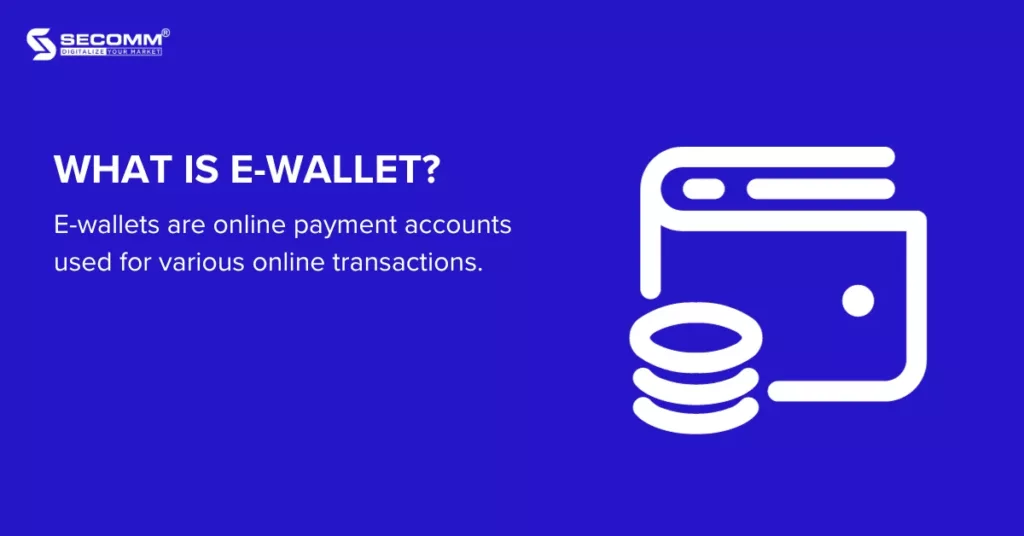
E-wallets are online payment accounts used for various online transactions. Payments through e-wallets are made by linking the account to a bank account, depositing money into the wallet, and then making simple and convenient payments for linked services. Some popular e-wallets in Vietnam include Momo, ZaloPay, etc.
- Popularity: 20% (2020)
- Benefits:
- Convenient smartphone payments.
- Save transaction time.
- Reduce the risks associated with cash transactions.
- Easy and safe account checking and management.
- Low usage fees for financial transactions compared to other features with the same functionality.
Scratch cards
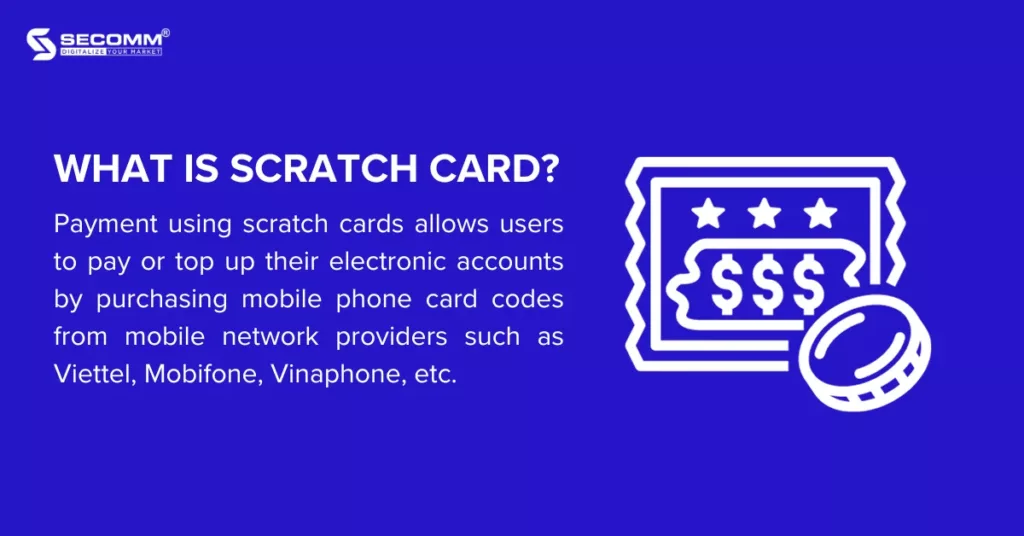
Payment using scratch cards allows users to pay or top up their electronic accounts by purchasing mobile phone card codes from mobile network providers such as Viettel, Mobifone, Vinaphone, etc. However, this payment method is usually only applicable to specific ecommerce platforms and websites.
- Popularity: 6% (2020)
- Benefits:
- Quick payments at various price points (20,000 VND, 50,000 VND, 100,000 VND, etc.).
- Reduce the risks associated with cash transactions.
Brand-specific cards/wallets
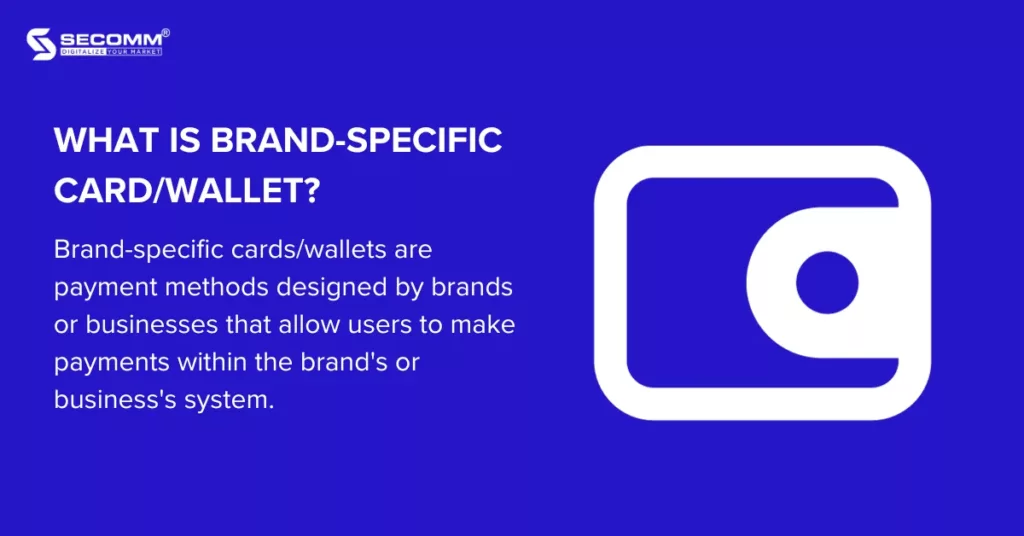
Brand-specific cards/wallets are payment methods designed by brands or businesses that allow users to make payments within the brand’s or business’s system. Examples include Shopee’s wallet, Lazada’s eM wallet, Starbucks’ card, VinGroup’s VinID, etc.
- Popularity: This payment method has only recently started gaining popularity, particularly among large brands.
- Benefits:
- Convenient and quick payments.
- Reduce the risks associated with cash transactions.
- Enhance the brand for businesses.
- Collect user shopping behaviours and preferences for segmentation.
E-vouchers
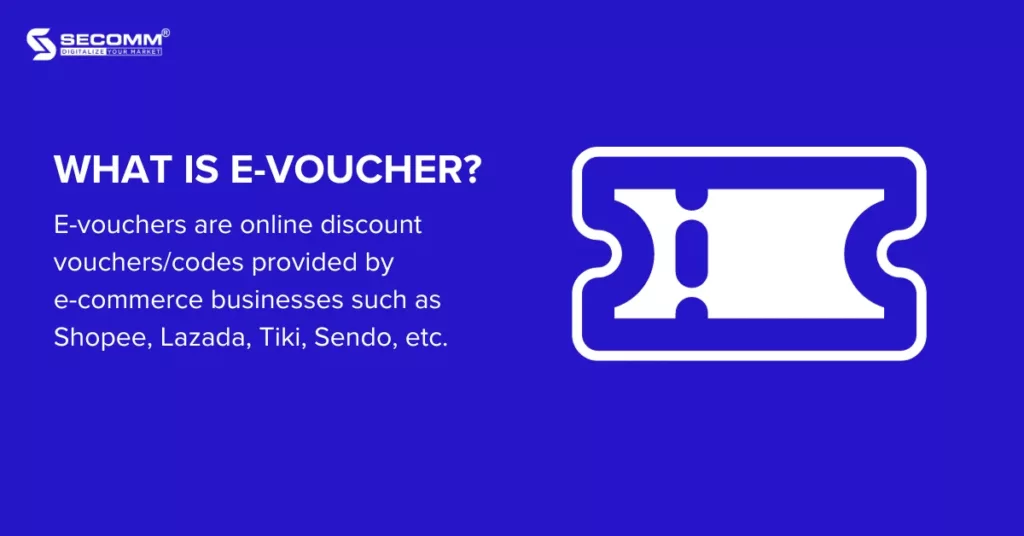
E-vouchers are online discount vouchers/codes provided by e-commerce businesses such as Shopee, Lazada, Tiki, Luxstay, etc. Customers can use them flexibly and conveniently to choose products and services and make payments using e-vouchers.
- Popularity: This payment method has been around for a long time and is favoured by young people for its convenience and savings when shopping.
- Benefits:
- Quick and convenient payments with various discounts.
- Enhance the brand for businesses.
The most popular payment method in ecommerce today is COD. However, due to the “digital transformation” nature of the ecommerce market, electronic payment methods are developing and becoming a new trend in payment services.
In 2020 alone, the revenue from the electronic payment market reached 8,904 million USD, a growth of 14.2% compared to 2019 (according to the Landscape 2020 report). Additionally, developing brand-specific cards/wallets for businesses is a potential method for the ecommerce website payment services.
 2
2

 12,348
12,348

 0
0

 1
1
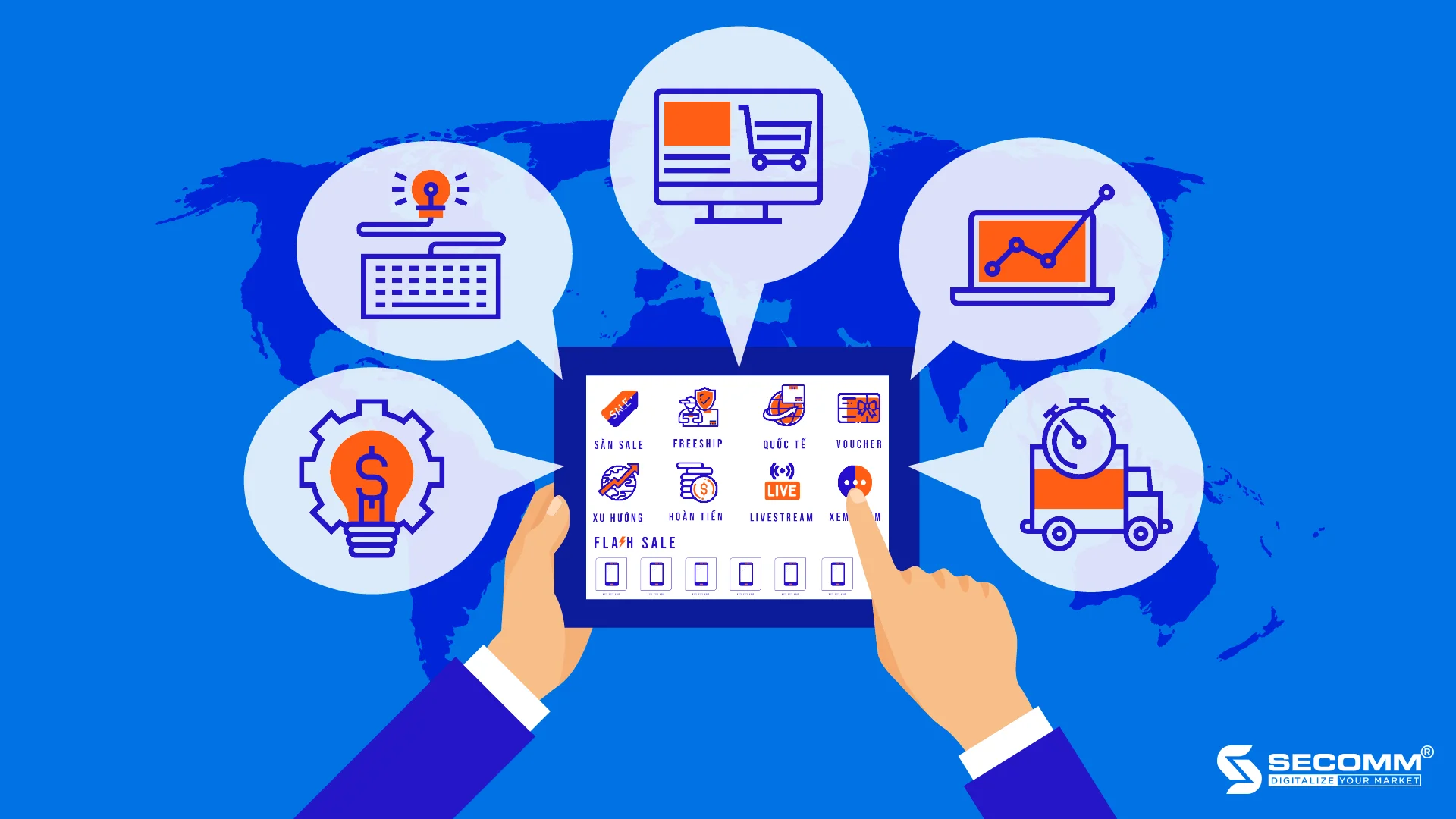
5 STEPS TO EFFECTIVELY IMPLEMENT ECOMMERCE FOR SMES
In the rapidly evolving landscape of today’s economy, where opportunities and competition are just a mouse click away, the effective implementation of E-commerce (EC) is a non-negotiable for businesses, regardless of their involvement in low or high-involvement industries. This comprehensive guide outlines the crucial steps that Small and Medium Enterprises (SMEs) can take to deploy and manage EC strategies successfully, ensuring a competitive edge in the digital marketplace.
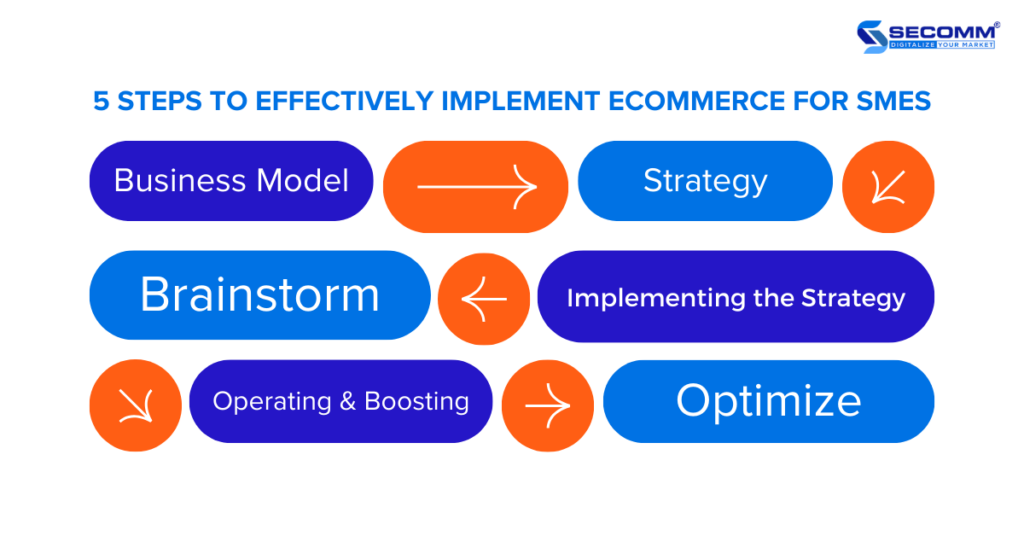
Step 1: Choosing the Right Ecommerce Business Model
The initial phase involves meticulous planning and selecting an EC business model that aligns with the overall development direction of the business. SMEs have three primary models to consider:
- B2B (Business to Business): Focused on transactions between businesses.
- B2C (Business to Customer): Tailored for transactions between businesses and end consumers.
- C2C (Customer to Customer): Involving transactions between individual customers.
Step 2: Developing an Ecommerce Strategy
Building a robust EC strategy is a cornerstone for SMEs. Leveraging the 5W1H method provides a structured approach to strategic planning:
- Who: Identifying potential customers and understanding target demographics.
- What: Defining the chosen business model and selecting technology solutions.
- When: Setting a clear timeline for the campaign, specifying start and end dates.
- Why: Establishing a compelling rationale behind the strategy, supported by relevant data.
- Where: Deciding on selling platforms—whether through social media, EC platforms, or the business’s own website.
- How: Planning the implementation strategy, considering external support from consulting companies or EC solution providers.
Step 3: Implementing the Ecommerce Business Strategy
The focus of this step is on determining purchasing channels and ensuring a seamless customer experience:
- Utilizing popular social media platforms such as Facebook, Instagram, and TikTok to reach a broader audience.
- Establishing stores on well-known EC marketplaces like Shopee, Lazada, Tiki, and Sendo.
- Collaborating with partners to build a professional EC website that reflects the brand’s identity.
- Consolidating content across various channels to provide a consistent and cohesive customer experience.
- Personalizing the user experience through the application of Artificial Intelligence (AI) for product/service recommendations and delivering relevant information.
Step 4: Operating and Boosting Ecommerce Sales
Once the EC system is operational, the emphasis shifts to maintaining and enhancing the system for optimal performance:
- Regularly maintaining, updating, and upgrading the system to adapt to the dynamic changes in the market.
- Implementing E-commerce Marketing strategies to stimulate online sales, including targeted promotions and advertisements.
- Utilizing Search Engine Optimization (SEO) techniques to attract customer attention on popular search engines.
Step 5: Optimizing Post-purchase Services in Ecommerce
Improving post-purchase services is essential for customer satisfaction and increased conversion rates:
- Offering multiple delivery options, including free delivery for a certain quantity, fast delivery, and flexible time options (Morning/Afternoon/Office hours).
- Leveraging E-logistics to enable customers to track and update the order status conveniently through their mobile devices.
In Summary
The implementation of EC is a critical endeavor for SMEs, representing a transformative journey that, when executed effectively, can lead to sustainable growth and increased market share. However, navigating the complexities of the EC landscape requires a strategic approach and a wise investment of time and resources.
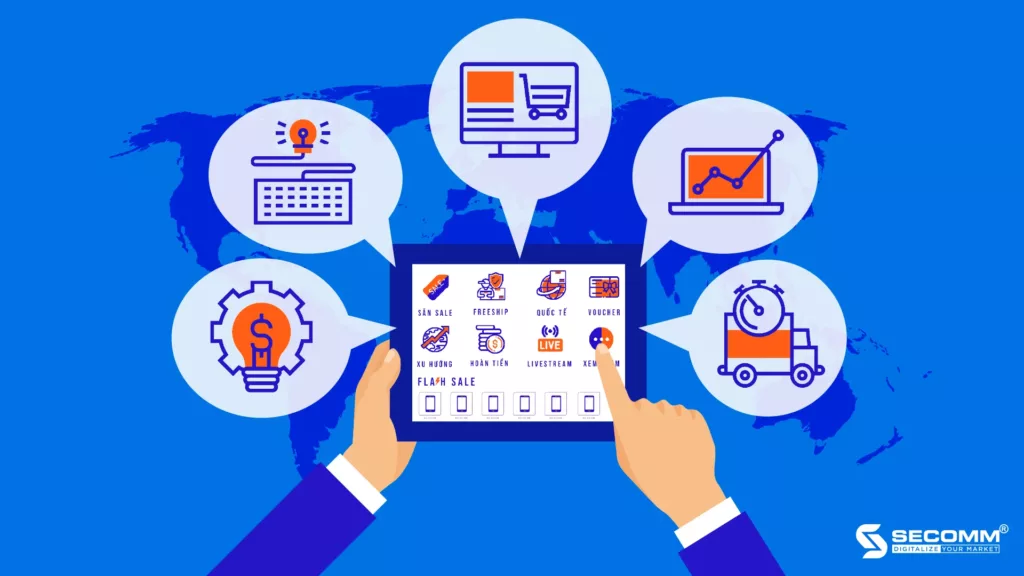
 2
2

 4,362
4,362

 0
0

 1
1
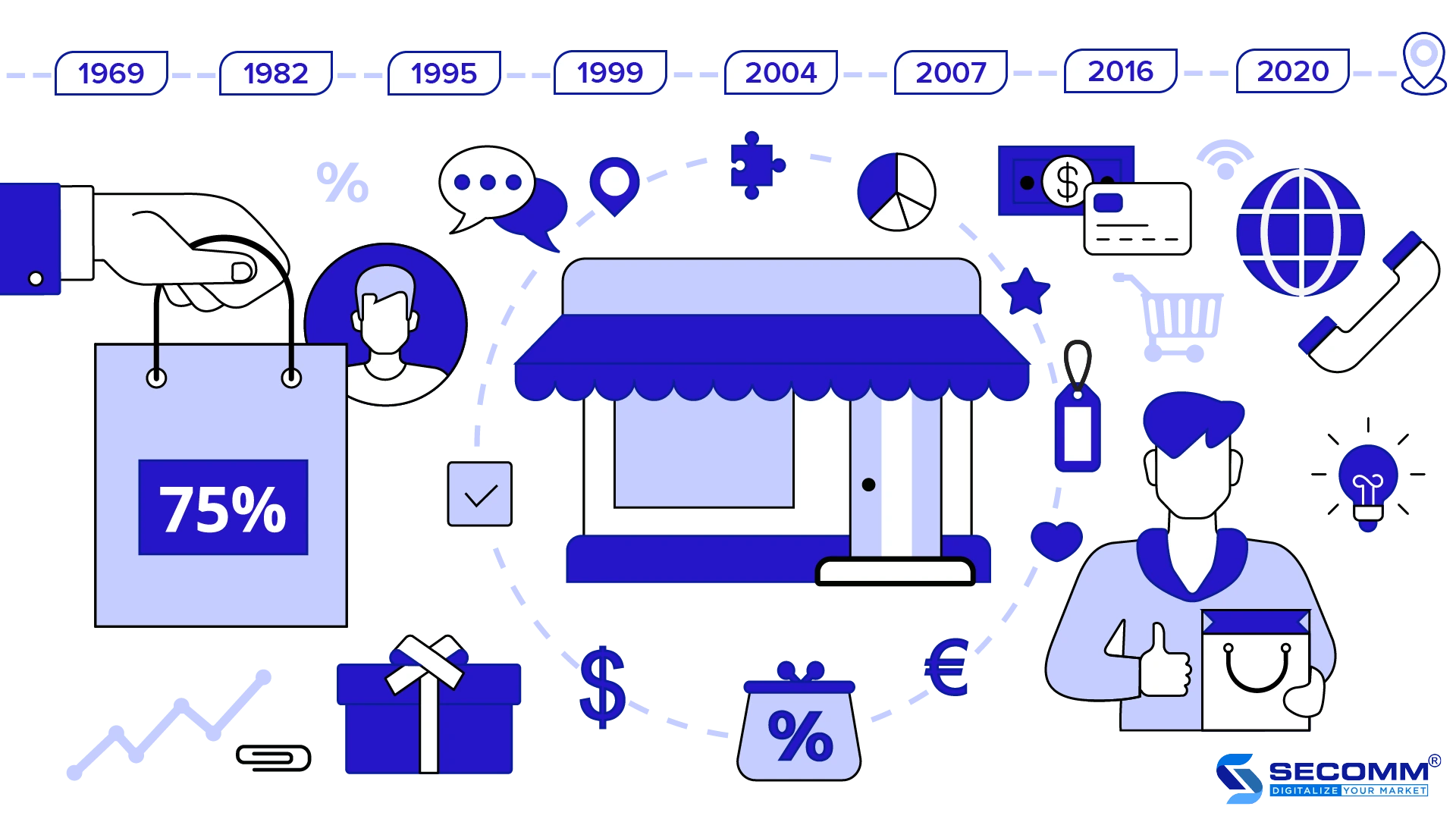
OVER 50 YEARS OF GLOBAL ECOMMERCE JOURNEY (1969 – 2020)
OVER 50 YEARS OF GLOBAL E-COMMERCE JOURNEY (1969 – 2020)
1969: The first online service provider – CompuServe
In 1969, Dr. John R. Goltz, Jeffrey Wilkins, and electrical engineering students founded CompuServe – a service that provided an information-sharing portal through the Internet and email network connections.
1979: Father of electronic commerce (EC) system – Michael Aldrich
Michael Aldrich pioneered the first EC system by connecting a television and a computer for transaction processing via telephone lines, enabling a secure information system to be opened and shared externally. This innovation laid the foundation for the development of modern EC systems.
1982: The first ecommerce company – Boston Computer Exchange
Initially a store supporting the resale of used computers, Boston Computer Exchange became one of the earliest models for today’s EC companies.
1992: The first online book market – Book Stacks Unlimited
Charles M. Stack established the brand Book Stacks Unlimited as the world’s first online book store. Initially using a dial-up bulletin board format, the company later transitioned to the Internet to create an online book trading market.
1995: Birth of the ecommerce giant – Amazon
Jeff Bezos founded Amazon initially as a book-selling business but later expanded its business model to include various products by incorporating new technologies such as cloud computing and artificial intelligence. Amazon ushered in a new era for the EC industry by integrating Internet technology into its business strategy.
1998: Online payment gateway, a platform for ecommerce development – PayPal
Confinity (the predecessor of PayPal) was founded by Max Levchin, Peter Thiel, Luke Nosek, and Ken Howery. In 2000, eBay acquired Confinity and renamed it PayPal, the world’s largest online payment gateway. PayPal addressed many limitations of traditional payment methods, making the buying and payment process more convenient and laying the foundation for EC development.
1999: The king of the ecommerce industry in China – Alibaba
Alibaba officially entered the EC market, successfully raising $25 million in capital. By 2001, the company became profitable and led the EC platform under the B2B, C2C, and B2C business models. In 2020, Alibaba contributed $12.2 billion to global EC revenue.
2000: Online advertising tool serving ecommerce marketing – Google AdWords
Google introduced Google AdWords, the world’s first online advertising tool. This tool supported businesses in marketing their products on Google’s search network, boosting sales for EC companies at that time.
2004: The first ecommerce website development platform – Shopify
After unsuccessful attempts to build an e-commerce website selling snowboarding equipment on various platforms, Tobias Lütke and Scott Lake founded Shopify – the first platform supporting the development of EC websites worldwide. This platform enables users to easily create online stores without requiring extensive technical knowledge.
2005: Ecommerce event – Cyber Monday
The National Retail Federation (USA) coined the term “Cyber Monday” to describe the first Monday after Black Friday, initiating the online shopping season between Thanksgiving and Christmas. This event marked economists’ interest in the global retail market.
2007: Sustainable ecommerce development platform – Magento
Developed by Roy Rubin and Yoav Kutner in 2007, Magento is an open-source platform written based on the Zend Framework and PHP programming language, specifically designed to build complex EC websites. Magento, known for its multitasking capability, high performance, flexible customization, and easy scalability, has become the top choice for enterprises with 200,000 partners and 2.5 million downloads worldwide.
Multinational corporations using Magento to build sophisticated EC systems include Samsung, Nike, Coca-Cola, Asus, HP, Lenovo, Canon, Sigma, Olympus, Port, Pox, Nestle, BevMo, Burger King, and millions of small and medium-sized EC sites globally.
2016: Facebook joins the ecommerce
game – Facebook Marketplace
With the ambition to dominate the EC market, Facebook, a tech giant, continuously introduced new features on Facebook Marketplace, Instagram, and WhatsApp, and collaborated with various EC platforms (Shopify, OpenCart, BigCommerce, WooCommerce, and Magento). This made giants like Amazon, Lazada, and Shopee wary, demonstrating the strong allure of the EC market.
2017: Growth of ecommerce
The global EC industry set a new revenue record of $2.352 trillion in 2017, a 25% increase from 2016 (according to eMarketer – a US market research company). Cyber Monday alone surpassed $6.5 billion in online sales. Economists predict that EC will be the world’s focal industry by 2025.
2020: COVID-19 boosts the ecommerce explosion
2020 marked a significant turning point for the global EC industry. The impact of COVID-19 accelerated the construction of EC systems to meet consumer demands promptly. Currently, EC is not only present on platforms like Amazon, Shopee, and Lazada but also brands are starting to build their own EC websites. Additionally, EC spans various sectors from fast-moving consumer goods (fashion, food, technology) to service sectors (travel, finance, education, furniture, and real estate).
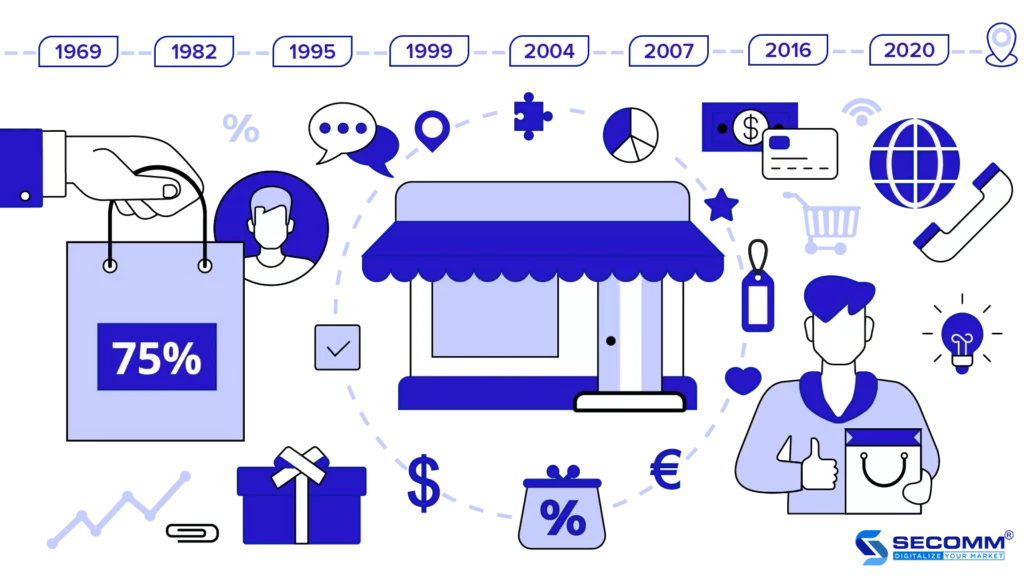
According to the “Southeast Asia Internet Economy 2020” report by Google & Temasek, consumers tend to spend more time shopping online than before COVID-19 (increased from 3.7 hours/day to 4.7 hours/day). Global B2C EC revenue increased from $1.948 trillion to $4.280 trillion, doubling Statista.com’s forecast of $2.238 trillion.
COVID-19 has brought positive effects on the global rise of the EC industry and opened up new opportunities for the Vietnamese economy.
 2
2

 4,544
4,544

 0
0

 1
1



